Integrating Local Planning Organizations into the State's Highway Safety Improvement Program (HSIP)
Downloadable Version
PDF [269B]
Proceedings from an HSIP Peer Exchange
About the Peer Exchange
The Federal Highway Administration's (FHWA)'s Highway Safety Improvement Program (HSIP) Peer-to-Peer Program (P2P) supports and sponsors peer exchanges and workshops hosted by agencies.
Date
May 12, 2010
Location
Indianapolis, Indiana
Hosts
Indiana MPO Council
Indiana Department of Transportation
Participants
Indiana Local Transportation Assistance Program — Purdue University
Mid-Ohio Regional Planning Commission
Southeast Michigan Council of Governments
Delaware Valley Regional Planning Commission
Other Local Public Agencies
FHWA Indiana Division Office
FHWA Office of Safety
U.S. Department of Transportation's (U.S. DOT) Volpe National Transportation Systems Center
FHWA's Office of Safety sponsors HSIP P2P events.
Learn more
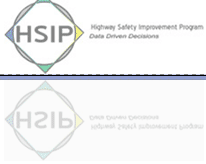
1. Background
In 2009, the Indiana Department of Transportation (INDOT) Office of Traffic Safety staff developed the Local Highway Safety Improvement Program Project Selection Guidance to support the goals of the State's Strategic Highway Safety Plan (SHSP) for improving safety on local roads. The guide outlines procedures for metropolitan planning organizations (MPOs) and local public agencies (LPAs) to identify high quality safety improvement projects for the use of Highway Safety Improvement Program (HSIP) funds, including:
- Monitoring network performance relative to traffic safety;
- Screening locations for safety issues;
- Identifying feasible crash countermeasures;
- Analyzing cost effectiveness of alternative investment choices; and
- Prioritizing needs among candidate projects.
To enhance the guide, INDOT consulted the Indiana MPO Council. Initial feedback indicated that additional information was needed in the document to provide assistance for developing successful HSIP project submissions, particularly for those organizations with limited staff and resources. The issues that needed to be addressed to ensure a successful program included:
- Quality of crash data and restrictions on its accessibility;
- Training for road safety audits;
- Information on analysis tools; and
- Additional technical support for local agencies outside of an MPO area.
As part of its overall strategy to improve local road safety, INDOT and the Indiana MPO Council coordinated with the Federal Highway Administration (FHWA) Office of Safety to organize a peer exchange. The peer exchange would bring together Indiana safety stakeholders to discuss opportunities for MPOs and LPAs to work collaboratively with INDOT to improve safety. As part of the peer-to-peer process, the organizers of the exchange met over several weeks to identify peers that could assist the State with improving local participation in its HSIP program. All the peer agencies that participated in this peer event had experienced some level of success with local HSIP project implementation approaches and techniques. The selected peers included: Mid-Ohio Regional Planning Commission (MORPC), Southeast Michigan Council of Governments (SEMCOG), and Delaware Valley Regional Planning Commission (DVRPC). These peers were selected in order to engage Indiana’s MPOs in their HSIP process.
The objectives of the peer exchange were to:
- Discuss highway safety issues and current programs in Indiana;
- Explain the value and purpose of the HSIP process to stakeholders
- Provide MPOs and LPAs guidance on how to have more input and control over how Indiana’s HSIP funds are spent;
- Learn about the noteworthy experiences of peer MPOs with HSIP implementation
- Create an ongoing dialogue to improve highway safety among Indiana’s HSIP stakeholders; and
- Identify next steps to improve the HSIP process for local agencies and reduce traffic fatalities.
More than 40 professionals representing 11 MPOs, the Indiana Local Technical Assistance Program (LTAP), and four INDOT district offices participated in the event. Appendix A provides the list of the event planners and presenters. The peer exchange included a brief overview of current trends, safety programs, and practices, followed by a panel discussion on the state of the practice for HSIP in Indiana. Each peer agency gave presentations describing the approaches and techniques used to successfully implement its HSIP projects. Following the presentations, breakout groups identified strategies and next steps to improve Indiana’s HSIP process. The breakout groups were structured ahead of time to include a mix of representatives in order to provide different perspectives on the HSIP implementation processes.
This report provides a summary of the presentations and discussions that took place during the peer exchange, including next steps that INDOT will take to improve its local HSIP project selection process.
back to Table of Contents
2. Preparing for Indiana’s Peer Exchange Event

Planning a Peer
Exchange
Identify
Champions
•
Engage State
DOT Leaders
•
Select and Invite
Peers
•
Recruit
Participants
•
Distribute
Background
Information
•
Host the Event
The success of a peer event is due in part to the comprehensive planning efforts to design the peer exchange. Key safety staff at INDOT and the Indiana MPO Council, along with the FHWA Office of Safety, spent approximately four months preparing for the peer exchange. The organizers of the peer event followed the key steps outlined below.
- Identify champions and engage State DOT leaders — INDOT’s Office of Traffic Safety led the effort on the HSIP, supported by the Indiana MPO Council and the Indiana LTAP at Purdue University. Key individuals from these groups initiated the peer exchange and remain engaged as champions for implementing actions for improvements. The involvement of INDOT leaders in the event was important to add credibility to the process and ensure that the actions identified for improvement are implemented.
- Select and invite peers — Event organizers identified and invited three peer agencies that have had successful experiences with implementing local HSIP projects: MORPC, SEMCOG, and DVRPC. Selecting peers that have been successful at addressing the host agency’s HSIP program gaps was essential to a successful HSIP Peer-to-Peer event for Indiana.
- Recruit participants — Both rural and urban agencies were invited to attend the event as well as the INDOT district offices and headquarters staff. Bringing these groups together created an opportunity for Indiana’s planners and engineers to work together, at the event and in the future. The attendance of these participants was critical to addressing a key objective of the event: engaging the MPOs and LPAs to assume responsibility in the HSIP local project selection and implementation process.
- Collect and distribute background information — Participants received background materials related to Indiana’s HSIP one week prior to the event. Materials included the Local Highway Safety Improvement Program Project Selection Guidance (document and checklist), the 2006 SHSP, the Draft 2010 SHSP, and the Indiana Crash Snapshot. Links to the Indiana Criminal Justice Institute’s 2008 Indiana Crash Fact Book and FHWA’s Implementation Process Models (IPMs) were also emailed to registrants. Pre-event preparation allowed more time for attendees to address strategies to improve the HSIP process in Indiana during the event.
- Host the peer event — FHWA Office of Safety staff and the Indiana planning team created an agenda for the peer exchange (see Appendix B) to address Indiana’s needs. They designed the agenda to provide the host state with an opportunity to learn about peer states’ experiences and to identify opportunities to improve the host state’s own processes through an open exchange of ideas, knowledge, and brainstorming. Templates were designed for the workshop portion of the event to provide a simple way to capture feedback for the Local HSIP Project Selection Guidance document.
back to Table of Contents
3. Proceedings of the Indiana Peer Exchange
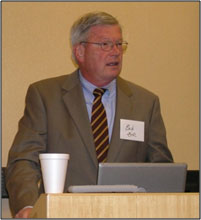
Bob Zier welcomes participants.
Welcome
Brad Mills, Executive Director of the Evansville MPO and Chair of the Indiana MPO Council Safety Committee, opened the meeting and introduced Bob Zier, Chief of Staff at INDOT to kick off the meeting. Mr. Zier’s remarks demonstrated INDOT’s commitment to safety and highlighted the importance of INDOT’s role in making Indiana’s roadways safer. Mr. Zier noted that roadway crashes cost the State $3.2 billion a year. In order to reduce the number and severity of crashes, INDOT is focusing on improving infrastructure and addressing the issues that cause crashes. Examining crash data to make improvement decisions is part of this process. Mr. Zier noted that INDOT is taking an aggressive stand to ensure that safety is the focus of construction projects.
Workshop Overview and Expected Outcomes
To set the framework for the peer exchange, representatives from the FHWA Office of Safety, the Indiana Division Office, and INDOT provided short overviews on the HSIP program, both nationally and in Indiana, and outlined the expectations for the workshop.
- FHWA summarized the national perspective on SHSP and HSIP processes, and stressed the importance of keeping MPOs and LPAs involved, and of using data to select projects in a streamlined process.
- INDOT’s Office of Traffic Safety works with INDOT’s Highway Safety Advisory Committee (HSAC) — including stakeholders from the County Engineers Association, FHWA, the Indiana MPO Council, and other INDOT divisions — to assist with project selection for HSIP. One-third of Indiana’s HSIP funds is targeted for local agencies. The Local HSIP Project Selection Guidance document is a work in progress and the agency welcomes feedback to learn how to improve the process.
- The FHWA Indiana Division Office emphasized that the goal of the workshop is to help stakeholders learn from one another and work together as partners to streamline the HSIP project selection process and save lives.
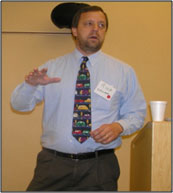
Rick Drumm of the FHWA
Indiana Division Office discusses
the workshop goals.
HSIP State of the Practice Panel Discussion
Brad Mills (Indiana MPO Council) and Roger Manning (Strategic Safety Plan Manager, INDOT) led a discussion about the HSIP state of the practice in Indiana and participants discussed the challenges and opportunities for improving safety. Challenges included the quality of data, limited funding for data collection, and the fact that the current guidance document does not allow for programmatic/systematic improvements.
Peer Presentations
Three peer agencies described the approaches and techniques they used to successfully implement their HSIP projects. The following section provides an overview of the presentations and some noteworthy practices.
SEMCOG
Tom Bruff, Manager of Transportation Programs with SEMCOG, described the agency’s involvement in the SHSP process and provided details on using the SHSP in the implementation of safety projects. Mr. Bruff emphasized the following steps that his organization has taken to create a successful HSIP process:
- Focus on data and information dissemination. SEMCOG provides as much information to the public as possible through press releases, transportation data maps, and community profiles, all accessible through the agency’s website. SEMCOG’s community profiles include transportation safety. Each profile provides a history (2000–2009) of total crashes. Crashes are also categorized by severity and involvement (cause) for the five-year period between 2005 and 2009 for each community. Finally, a list of the top ten high frequency crash locations and segments are listed. SEMCOG uses this information to encourage communities to conduct road safety audits and to select and prioritize safety projects.
- Coordinate State and local activity. In order to achieve a successful program, all stakeholders must work together. SEMCOG participates in a number of safety task forces and coalitions, which meet regularly to share data and discuss issues; some examples of these include the Governor’s Traffic Safety Advisory Commission, the Crash Data Users Group, the AAA Michigan Traffic Safety Committees, and the Macomb County Traffic Safety Association. As a participant in the development of the Michigan SHSP, SEMCOG contributes to the SHSP emphasis action teams, each focused on one of 12 emphasis areas identified on the basis of crash data, such as alcohol/drug impaired driving and pedestrian and bicycle safety. The action teams provide a report on the effectiveness of strategies twice per year and, based on a review of the performance measures, adjustments are made as needed.
- Build education and awareness. SEMCOG reaches out to the public through multiple avenues. Examples include providing training (SEMCOG Universities) through workshops and web seminars. Recent SEMCOG Universities related to safety have included training on Designing Pedestrian Facilities, Road Safety Audits (RSA), Access Management, and Walkable Communities.
- Engage local governments through RSA. SEMCOG employs a unique process for RSA to obtain buy-in on safety projects from local agencies. Staff meet with the local governing body (e.g. the City Council) to present the project and the locals must then sign a Memorandum of Understanding with SEMCOG to ensure their commitment. Before and after studies are presented to the locals to document the impact of the improvements.
- Adopt and monitor performance measures. SEMCOG provides evidence to its members that safety projects can improve efficiencies by tracking performance measures, such as the reduction in serious injury crashes at intersections as a result of signal retiming. Tracking performance measures offers credible proof that safety projects are worth the investment.
MORPC
Kerstin Carr of the MORPC provided information on the involvement of MPOs in implementing safety projects. MORPC’s role in the HSIP process is to assist the Ohio Department of Transportation (ODOT) and the Ohio Department of Public Safety (ODPS) with safety efforts on a regional level and to help local governments and organizations with their specific safety programs. The following are key strategies to MOPRC’s success:
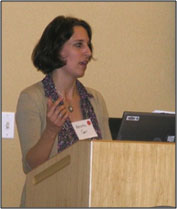
Kerstin Carr of MORPC describes
working with ODOT and ODPS.
- Improve accuracy of crash data. Ohio safety partners work collaboratively to ensure a high level of complete and accurate crash data. Through the Crash Data Education Project, MORPC provides a training video to law enforcement and promotes ODPS’ efforts to provide GPS units and laptops to agencies that need them. The educational video focuses on the communication challenges that previously existed between Ohio’s law enforcement officers and planners/engineers. Created as a collaborative effort between MORPC, ODOT, ODPS, and local agencies, the video stresses the importance of accurate crash reporting for effective safety planning.
- Share crash data. MORPC hired a consultant to help clean up the crash data for its transportation planning area. These data and other safety related resources are shared through a SharePoint website called Crash Point. ODOT also provides web tools such as GIS Crash Analysis Tool, an online Geographic Information System (GIS) analysis tool, for MPOs to review crash trends and patterns for specific projects. The top 40 annual high crash locations are identified for the region; separate lists for ped-bike high crash locations and corridors are also mapped for the region and each city. These lists and maps assist MORPC and the local governments in planning for safety projects.
- Build education and awareness. MORPC promotes safety education through webinars and forums as well as its website. Examples of recent safety initiatives featured on the MORPC website include information on distracted driving and the “Click It or Ticket” campaign. Addressing high-risk travel behaviors and special populations is another MORPC goal. MORPC works closely with Public Safety and community groups to address the human side of crashes; examples of this work include seatbelt campaigns and cell phone legislation.
- Support multi-agency collaboration. MORPC participates in numerous safety committees with partner agencies and represents Ohio’s MPOs on the statewide safety plan and the Traffic Records Coordinating Committee. MORPC supports multi-agency and multi-jurisdictional safety efforts, including Safe Routes to School forums and road safety audits.
- Assist local governments in obtaining HSIP funds. MORPC develops annual regional high-crash location lists to identify projects likely to be eligible for HSIP funds. MORPC’s website includes a section on “Funding Sources for Roadway Safety Projects,” which provides an overview of funding opportunities for local roadway safety projects including contact information.
- Encourage non-motorized travel. MORPC advocates for initiatives such as the Complete Streets Policy, RideSolutions, and Advanced Traveler Information Systems (ATIS) to encourage biking, walking, and public transit use, which may also lead to safer travel overall. A Bike User Map developed in partnership with the City of Columbus and a local bicycle advocacy group also encourages other modes and provides safety education.
DVRPC
John Ward of the DVRPC provided details on the steps his agency has taken to systematically improve transportation safety in the Delaware Valley. Mr. Ward’s presentation focused on the following areas contributing to the success of DVRPC’s safety program:
- Use State DOT tools. DVRPC uses crash data analysis tools available from the State DOTs in New Jersey and Pennsylvania. New Jersey DOT’s (NJDOT) Plan4Safety is a comprehensive crash data tool that includes a countermeasure generator as well as a predictive modeling resource for data-driven safety decisions. Pennsylvania DOT’s (PennDOT) Crash Data Analysis and Retrieval Tool (CDART) is a GIS-based tool which allows users to input data into maps and reports. DVRPC uses these tools to prepare crash data summaries and analysis for a number of safety planning studies and in the project evaluation and selection process.
- Obtain funding for projects. Staff works with the State DOTs to allocate HSIP funds directly to DVRPC to implement safety projects. In New Jersey, NJDOT’s Local-Federal Safety Program (LFSP) allocates funds for use on non-State-owned roads. A subset of the LFSP in New Jersey is the High Risk Rural Roads Program. Both programs require locals to follow the Federal funding process and provide a demonstrated crash history. PennDOT has similar programs to allocate safety funds to projects through the DVRPC Transportation Improvement Plan (TIP) process. In both States, DVRPC conducts data analysis and selects project locations in coordination with its safety partners.
- Conduct Road Safety Audits (RSAs). Working with local governments, DVRPC staff manage and coordinate the RSA process including preparing materials, inviting participants, and coordinating the site visit. Invitees typically include representatives from the State, county, and municipality, as well as the transit and biking communities. Local roadway maintenance staff are also encouraged to attend in order to find new ways to provide quick fix, low cost solutions.
- Create a Regional Safety Task Force. DVRPC has convened a multimodal and multidisciplinary group that meets quarterly. The meetings provide opportunities to educate stakeholders on emphasis areas and other safety topics. The task force guided the development of the 2009 Regional Safety Action Plan designed to identify regional safety emphasis areas to facilitate project selection for HSIP funding. The safety plan is coordinated with PennDOT’s and NJDOT’s SHSPs. Two other tasks managed by this group include the publication of Traffic Crash Analysis of the Delaware Valley and the creation of Emphasis Area summary cards used to educate stakeholders. The cards provide an informative resource that are distributed at public events and include a definition of each emphasis area as well as recommended strategies to reduce crashes.
- Promote education and outreach. Communicating to the public represents a critical element of DVRPC’s safety program to ensure that stakeholders remain informed. DVRPC uses its website to provide information and resources to the public. Convening groups such as the Regional Safety Task Force is also an effective way to keep stakeholders informed. DVRPC has defined next steps in its program to include continuing legislative safety symposium efforts and educating the State and local judiciary regarding the safety implications of waiving or plea bargaining moving violations.
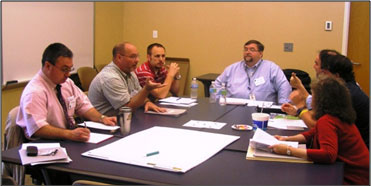
Mike Holowaty of INDOT leads a group during the breakout session
Breakout Sessions
In the afternoon, participants were divided into five working groups. In this first part of the breakout session, each group discussed Indiana’s draft HSIP Local Project Selection Guidance document and process and identified its strengths, weaknesses, and opportunities for improvement. The groups reported their findings to the complete group, and together identified themes where opportunities for improvements exist.
During the second part of the breakout session, the groups focused on identifying potential strategies to improve assistance for MPOs and LPAs working with INDOT’s HSIP program. Each team developed strategies, including required resources and champions and a realistic timeframe for implementation. Top strategies were reported out to the whole group. Planning worksheets were supplied to each group to document its work and a facilitator moderated the session.
Strategies that the breakout groups identified to improve the HSIP process for MPOs and LPAs included:
- Continue to make MPOs and LPAs a central part of the HSIP process by keeping them informed and involved;
- Create a contract book for safety projects (similar to the book used for projects in the American Recovery and Reinvestment Act of 2009) to allow a quick and easy method for implementing safety projects;
- Develop web-based and in-person training modules for the safety project development process;

The event generated many good ideas to
improve our local HSIP guidance
document to better serve the MPOs and
rural highway agencies. I think in the
long run, the quantity and quality of
applications for funding will improve
because of this workshop.
Mike Holowaty, INDOT Office of Traffic Safety

- Incorporate programmatic improvements in the SHSP update by identifying related emphasis areas;
- Consider establishing a categorical exclusion for programmatic improvements;
- Develop instructions for conducting road safety audits and encourage experienced peers to assist other MPOs and LPAs;
- Address issues with inconsistencies and accessibility conflicts with the Indiana crash database; and
- Work with the Indiana LTAP to assist local governments with the HSIP application process.
Next Steps
Based on the strengths, weaknesses, and recommended strategies developed during the breakout sessions, INDOT identified the following next steps to improve its local HSIP project selection process:
- INDOT will convene a working group to revise the Local HSIP Project Selection Guidance document to provide MPOs and LPAs with a clear direction on how to identify safety improvement projects. The working group will focus on developing guidelines for low-cost, systematic improvement project selection on local roads, and providing clear direction on the selection process for urban projects (within an MPO area) versus rural projects (outside of the MPO area). The revised guidance document will include:
- Hyperlinks to resources identified in the guide;
- Templates for applications;
- Checklist with requirements for applications;
- Examples of projects for both programmatic and site specific applications; and
- Improvements to the document formatting.
- INDOT staff will distribute the revised document in conjunction with the Indiana MPO Council with a request for comments. INDOT will revise the document accordingly and send out a final draft for approval.
- Once the revised document is finalized, INDOT will issue a new call for projects.
Following revision of the guidance document, INDOT’s working group is expected to continue to meet to improve the HSIP project selection process. The working group will be expected to assist in the implementation of the future steps outlined above, to continuously monitor the program’s performance, and to recommend changes as needed.
back to Table of Contents
4. Key Findings and Lessons Learned
The purpose of a peer exchange is to allow participants to learn from one another and incorporate advice, suggestions, and noteworthy practices into their own activities. Indiana combined the opportunity to learn from other States with the important task of updating its HSIP guidance document for local roads. The following lessons learned, which are derived from Indiana’s peer exchange, may be helpful to other States as they work with MPOs and LPAs to identify local safety projects for the HSIP.

The greatest benefit of the workshop was
"networking between the MPOs, INDOT,
and FHWA."
Duane Myers, Greenfield District

- State DOT leadership and safety partners need to be involved in the HSIP process early and often. Support from the State DOT is necessary to ensure that the actions identified for safety improvements move forward. It is as equally important to engage safety partners throughout the process. These partners should be involved in developing and reviewing guidance documents. Establishing working groups is an effective method to involve stakeholders and can help educate a diverse group of partners on the importance of safety on Indiana’s local roads.
- A guidance document is important for MPOs and LPAs to use in understanding the local HSIP process. Although participants provided many suggestions for improving the document, the consensus among the groups was that the existence of the Local HSIP Project Selection Guidance document was critical. MPOs and LPAs clearly need assistance navigating the HSIP process and INDOT’s guide was considered an important part of making that happen.
- Crash data needs to be accurate and accessible to provide the foundation for prioritizing safety issues and improvement efforts. The peer presentations demonstrated how data can be used to identify those areas where the investment of resources would generate the greatest benefit. Indiana’s crash data system is a work-in-progress. In order to make data-driven decisions, as required by HSIP, the flaws in the system need to be addressed. Ensuring that locations are coded correctly will help, however, there are obstacles to making the necessary changes due to Indiana State Police’s (ISP) privatization of the crash report database. Indiana’s Traffic Records Coordinating Committee should continue to work with the ISP to make progress towards improving base mapping and crash report coding. Improvements to the system will help INDOT, the MPOs, and LPAs develop projects to help save lives in Indiana.
back to Table of Contents
5. Feedback and Suggestions
Indiana’s experience using a peer exchange for its HSIP guidance document was both productive and positive. Rick Drumm, the safety specialist in Indiana’s FHWA Division Office indicated that he was "...very pleased with the results. Lines of communication were opened and a better atmosphere of improving the program together seemed apparent." Feedback from the participants consistently indicated the significant value of meeting with their safety peers at the event and having the opportunity to work with INDOT on the local HSIP process.
For future events, participants suggested providing a web conference for those unable to attend, particularly during the peer presentations and question and answer sessions.
back to Table of Contents
Appendix A: Presenters and Planners
Rosemarie Anderson
FHWA Office of Safety
1200 New Jersey Avenue SE
Washington DC 20590
Office Phone: (202) 366-5007
Email: Rosemarie.Anderson@dot.gov
Tamiko Brim-Burnell
FHWA Office of Safety
1200 New Jersey Avenue SE
Washington DC 20590
Office Phone: (202) 366-1200
Email: Tamiko.Burnell@dot.gov
Tom Bruff
Manager, Transportation Programs
Southeast Michigan Council of Governments
535 Griswold Street, Suite 300
Detroit, MI 48226-3602
Office Phone: (313) 961-4266
Email: bruff@semcog.org
Kerstin Carr
Manager, Active Transportation & Safety Programs
Mid-Ohio Regional Planning Commission
111 Liberty Street, Suite 100
Columbus, OH 43215
Office Phone: (614) 233-4163
Email: kcarr@morpc.org
Rick Drumm
Traffic/Safety
FHWA Indiana Division Office
575 N. Pennsylvania Street, Room 254
Indianapolis, IN 46204
Office Phone: (317) 226-7487
Email: Rick.Drumm@dot.gov
R. Benjamin Gribbon
FHWA Office of Safety
1200 New Jersey Avenue SE
Washington DC 20590
Office Phone: (202) 366-1809
Email: Benjamin.Gribbon@dot.gov
Mike Holowaty
Manager, Office of Traffic Safety
Indiana Department of Transportation
Indianapolis, IN 46204
Office Phone: (317) 232-5337
Email: mholowaty@indot.in.gov
Roger Manning
Office of Traffic Safety
Indiana Department of Transportation
Indianapolis, IN 46204
Office Phone: (317) 232-5204
Email: rmanning@indot.in.gov
Brad Mills
Executive Director
Evansville MPO
Civic Center Room 316
1 N.W. Martin Luther King Blvd.
Evansville, IN 47708-1833
Office Phone: (812) 436-7833
Email: bmills@evansvillempo.com
John Ward
Associate Director, Planning Division Delaware Valley
Regional Planning Commission
American College of Physicians Building
190 North Independence Mall West
Philadelphia, PA 19106
Office Phone: (215) 238-2899
Email: jward@dvrpc.org
back to Table of Contents
Appendix B: Agenda
INDIANA'S HSIP PEER EXCHANGE EVENT
Wednesday, May 12, 2010
Location: Indianapolis, Indiana
| 8:00 |
Welcome — Bob Zier, Indiana Department of Transportation |
| 8:15 |
Meeting Purpose and Introductions — Brad Mills, Evansville MPO |
| 8:30 |
Transportation Safety Panel Discussion and FAQ — Tamiko Burnell - FHWA, Office of Safety, Mike Holowaty - INDOT, and Rick Drumm - Indiana Division Office |
| 9:00 |
Indiana MPO Lead Discussion Session — Brad Mills, Evansville MPO and Roger Manning, INDOT
- What are the challenges to improving safety?
- What are opportunities for improving safety?
|
| 9:30 |
Highway Safety Improvement Program: Involvement of MPOs and Implementing Safety Projects — Kerstin Carr - Mid-Ohio Regional Planning Commission |
| 9:45 |
Missouri's Systemic Approach to Saving Lives — Jon Nelson, Missouri Department of Transportation |
| 10:00 |
Break |
| 10:15 |
Michigan: SEMCOG’s Involvement in the SHSP Process and Using the SHSP in the Implementation of Safety Projects — Tom Bruff - Southeast Michigan Council of Governments |
| 10:45 |
Systematically Improving Transportation Safety in the Delaware Valley — John Ward - Delaware Valley Regional Planning Commission |
| 11:15 |
Q & A with Peer Presenters |
| 12:00 |
Lunch |
| 1:00 |
Group Activity
- Identify the strengths, weaknesses, and opportunities in the State’s existing Local HSIP Project Selection Guidance program. The focus of the activity is to enhance the HSIP/SHSP prioritization process and project implementation.
|
| 2:00 |
Report Out |
| 2:15 |
Break |
| 2:30 |
Group Activity — Continued
- List three resources that your office can contribute to the integration of safety into the transportation planning process and program.
- Identify and recommend the champions and partners for advancing next steps and indicate a timeframe for making these changes.
|
| 3:30 |
Report Out |
| 3:45 |
Wrap-Up/Next Steps |
| 4:00 |
Adjourn, Safe Trip Home |
back to Table of Contents









